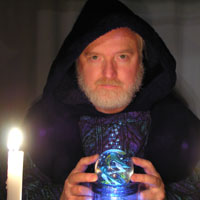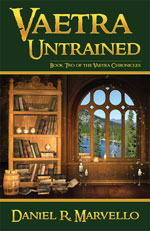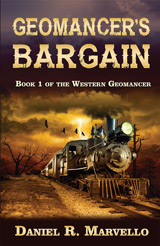My grandfather was a huge fan of the westerns “Gunsmoke” and “Bonanza.” I sat with him and watched those television shows many times while visiting my grandparents as a young boy. I didn’t experience the joy of books set in the Old West until I was in high school and discovered The Sacketts by Louis L’Amour. Hollywood has produced many Westerns over the years, and I’ve spent many hours watching them, from the old classics to the latest adventures.
Fantasy has also been a part of my entertainment life for as long as I can remember. I’ve enthusiastically consumed games, books, television shows, movies, and even music with fantasy elements.
I suppose it was inevitable that I would eventually merge my two interests at some point in my writing life and create a fantasy western series. My forthcoming book, Geomancer’s Bargain, is the first volume of that series.
Weaving Fantasy Elements into the Old West
When I sat down to create the story world for Geomancer’s Bargain, I had many decisions to make. I picked a real-world region (Cochise County, Arizona) and set the story among many real-world landmarks. I had no intention of including any genuine historical characters in the stories, but I did borrow several surnames from the history books. I chose the mid-1890’s as the base time period from a technology standpoint.
Then came the fantasy elements. I added two fantasy races and three fantasy creatures to the Geomancer’s Bargain story world. It took quite a bit of work to figure out how to weave those elements into an alternate Old West. (I wrote about that in my earlier article on the throes of world-building.) This article focuses on my version of golden dragons.
Introducing Golden Dragons
Adding dragons to a western may strike some readers as an odd thing to do. But if there’s anything the Southwest has, it’s heat and lizards. I think fire-breathing dragons fit right in.
Golden dragons have lizard-like bodies, but they don’t have wings. I modeled the dragons after the golden armadillo lizard, except they weigh about 1,500 pounds and have scales as tough as boiled leather. They lair in underground cave systems, coming to the surface to hunt and to sun themselves. They avoid civilization, but can be dangerous to humans traveling alone in remote locations.
Roasted Diet
Golden dragons are omnivorous, eating a wide variety of plants and animals. They are particularly fond of creosote bushes and desert broom. Both plants contribute resins to their miraculous digestive system.
I use the term miraculous because golden dragons are mobile, biological, bio-fuel generators. Their digestive process produces a flammable oil that is stored in a large gland near their lungs. When a dragon feels threatened or encounters large prey, it exhales a mist of the flammable oil. The mist is ignited by a hard, flint-like tooth at the front of their mouth that creates a spark when the dragon shifts its jaw forward in a specific way. The result is similar to what one can do with a flame-thrower. Not surprisingly, golden dragons have a fondness for seared meat. Most dragons can manage up to four good flames before emptying their fuel gland. It can take up to a month for the gland to fully recharge, although they can usually muster enough oil for a single flame within a week.
Behavior and Reproduction
Golden dragons are generally solitary, although males seek out females in the fall to mate. The females lay one or two eggs in an underground lair, usually in late-October. The eggs mature over the course of winter, and in the spring, the hatchlings emerge hungry. The hatchlings are typically two to three feet long and are capable of hunting their own food immediately.
Female dragons vigorously defend their eggs and their lair. Although females do not directly feed their hatchlings, they often leave behind part of their own meals for the hatchlings to consume. Male dragons do not eat hatchlings, although when hungry, they may chase the hatchlings away from food left behind by their mother.
Within a year, hatchlings grow to be about ten feet long, at which point their growth slows. They reach their full size of twelve to fifteen feet within five years, and their life expectancy is typically thirty years. They usually leave their mother’s territory and establish their own at the start of the new mating season, which begins approximately nine months after their birth.
Golden dragons are territorial. Males and females establish and defend separate territories that vary in size from approximately ten to forty square miles. Lair entrances are usually located high in the foothills of Southwestern mountain ranges. During the September/November mating season, female territories shrink to the area immediately around the lair, allowing male dragons to travel about. Females remain close to their lairs until they lay eggs, at which point they return to defending their entire territory.
Relationship to the Avens
Avens are the native people of the Southwestern mountain ranges. Golden dragons (known as Nadi Gaman in their language) are sacred to the avens, and all treaties stipulate the protection of these rare creatures. When establishing territorial borders, the avens often include known dragon territories to reduce the likelihood of conflict with settlers.
I’ll reveal more about the interaction between the avens and golden dragons in a future article on the avens.
* * * * *
I hope you enjoyed learning about golden dragons. They are the first dragons I’ve written into any of my works, and it was fun to offer a new take on a classic fantasy standard. If you would like to know when I publish another article about the Geomancer’s Bargain story world, the easiest way is to use the “Subscribe to new posts via email” option in the right sidebar. If you want to know when I release Geomancer’s Bargain, please sign up for release notices.
Happy reading!









